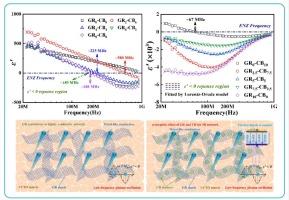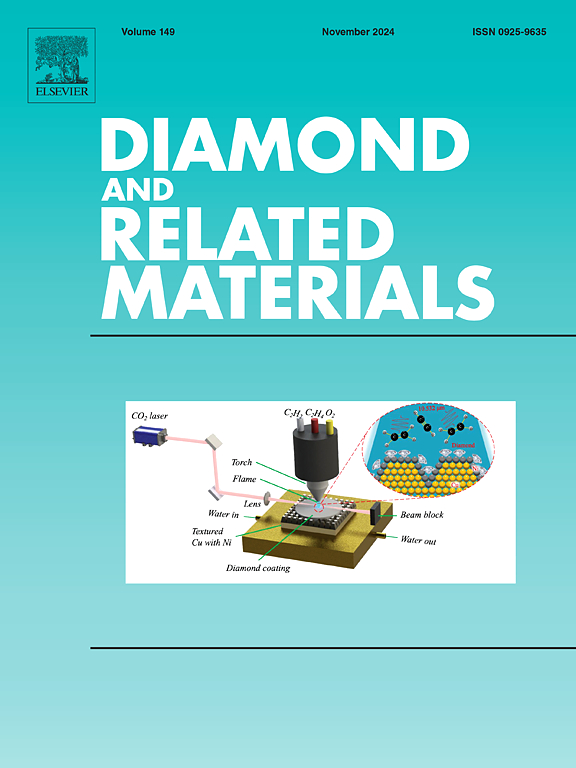通过三元元复合材料中石墨烯和炭黑的协同效应精确调节ε′负响应和ε′近零响应
IF 4.3
3区 材料科学
Q2 MATERIALS SCIENCE, COATINGS & FILMS
引用次数: 0
摘要
如何精确调节射频(RF)ε'-负和ε'-近零(ENZ)响应的幅度和色散特性是一项挑战。这一挑战极大地影响了多功能电子设备的设计。在本研究中,我们介绍了一种在三元元复合材料中利用石墨烯(GR)和炭黑(CB)实现可调ε'-负响应和ENZ响应的协同策略。由于在 CaCu3Ti4O12 基体中随机构建了三维(3D)导电石墨烯-炭黑网络,我们观察到了两种类型的ε'-负响应机制:电偶极子共振和低频等离子振荡,它们在不同的频段占主导地位。因此,由于这两种机制之间的相互作用,弱ε'-负值(0 < |ε'| 〈1000)和频率弥散得到了成功的调整。我们还在 580 MHz、225 MHz、189 MHz 和 188 MHz 的范围内调整了 ENZ 频率,并改变了 GR 与 CB 的比率。此外,我们还研究了ε'-负元复合材料的传导行为、损耗机制和电气特性,以揭示微结构变化与介电性能之间的关系。本文章由计算机程序翻译,如有差异,请以英文原文为准。

Precisely tuning ε′-negative and ε′-near-zero responses by synergistic effect of graphene and carbon black in ternary metacomposites
Understanding how to precisely regulate the magnitude and dispersion characteristics of radio-frequency (RF) ε’-negative and ε’-near-zero (ENZ) responses presents a challenge. This challenge significantly impacts the design of versatile electronic devices. In this study, we introduce a synergistic strategy utilizing graphene (GR) and carbon black (CB) in ternary metacomposites for tunable ε’-negative and ENZ responses. Due to the randomly constructed 3-dimensional (3D) conductive GR-CB networks in a CaCu3Ti4O12 matrix, we observed two types of ε’-negative response mechanisms: electric dipole resonance and low-frequency plasma oscillation, which dominate at different frequency bands. Consequently, the weakly ε’-negative values (0 < |ε’| 〈1000) and frequency dispersion were successfully adjusted due to the interplay between these two mechanisms. The ENZ frequencies were also tuned over ∼580 MHz, 225 MHz, ∼189 MHz and ∼ 188 MHz with variable GR-to-CB ratios. Furthermore, we studied the conduction behavior, loss mechanism, and electrical characteristics of the ε’-negative metacomposites to shed light on the relationship between microstructural changes and dielectric performance.
求助全文
通过发布文献求助,成功后即可免费获取论文全文。
去求助
来源期刊

Diamond and Related Materials
工程技术-材料科学:综合
CiteScore
6.00
自引率
14.60%
发文量
702
审稿时长
2.1 months
期刊介绍:
DRM is a leading international journal that publishes new fundamental and applied research on all forms of diamond, the integration of diamond with other advanced materials and development of technologies exploiting diamond. The synthesis, characterization and processing of single crystal diamond, polycrystalline films, nanodiamond powders and heterostructures with other advanced materials are encouraged topics for technical and review articles. In addition to diamond, the journal publishes manuscripts on the synthesis, characterization and application of other related materials including diamond-like carbons, carbon nanotubes, graphene, and boron and carbon nitrides. Articles are sought on the chemical functionalization of diamond and related materials as well as their use in electrochemistry, energy storage and conversion, chemical and biological sensing, imaging, thermal management, photonic and quantum applications, electron emission and electronic devices.
The International Conference on Diamond and Carbon Materials has evolved into the largest and most well attended forum in the field of diamond, providing a forum to showcase the latest results in the science and technology of diamond and other carbon materials such as carbon nanotubes, graphene, and diamond-like carbon. Run annually in association with Diamond and Related Materials the conference provides junior and established researchers the opportunity to exchange the latest results ranging from fundamental physical and chemical concepts to applied research focusing on the next generation carbon-based devices.
 求助内容:
求助内容: 应助结果提醒方式:
应助结果提醒方式:


